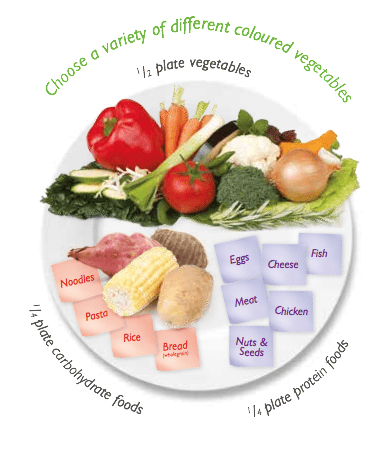Carbohydrate-rich foods like potatoes are a good source of energy. For a balanced diet, carbohydrates should supply just over half your daily calories or energy needs, with most of these coming from complex carbohydrates.
The big advantage of getting carbohydrates from potatoes, rather than pasta or rice, is that potatoes supply a wealth of other vital nutrients. Potatoes contain more dietary fibre, potassium and folate than rice or pasta. They also contain vitamin C which neither rice or pasta contain.
The main meal of the day should look like this.

Glycaemic index vs Glycaemic Impact
The Glycaemic Index (GI) ranks carbohydrate foods based on the speed at which they enter the bloodstream and the immediate effect on blood sugar levels. The faster the blood sugar response appears in the bloodstream after eating a food, the higher the food’s GI ranking.
A GI of less than 55 is considered ideal. Potatoes have a GI of 65-101 (depending on the variety and cooking method) which means their carbohydrates bet into the blood stream fast. However, when potatoes are eaten with other foods which contain fat, protein or fibre, their GI drops which means they are absorbed more slowly. Potatoes make up for their high GI because they are nutrient rich and play an important role in a diet.
What does GI ranking mean?
GI ranking is based on portions of food containing 50g of carbohydrates, but it does not consider that the carbohydrate content of food varies widely e.g. three potatoes would provide 50g of carbohydrates but you would have to eat a whole watermelon or 700g of carrots to get the same quantity of carbohydrates.
The mixed meal concept.
If potatoes are eaten as part of a meal with a protein such as low-fat cottage cheese, chicken or meat the overall GI will be lower. “You lower potatoes’ GI profile by eating them with fat or protein,” says Leslie Bonci, R.D., Director of sports medicine nutrition at the University of Pittsburgh Medical Center.
Glycaemic impact
Glycaemic impact is a way of measuring blood glucose response to food. The advantage of this measure is that glycaemic impact is like a nutrient – it has gram units and can be expressed as g/100g of food or g/serving of food, just like other nutrients on a food label.
Potatoes are in fact an excellent source of low-density energy. This means that the energy from potato comes from carbohydrate (17kJ/g) rather than fat (34kJ/g) and is diluted about eight times with water. The glycaemic impact of potato is easy to manage in a healthy diet.
When potato is cooked the starch gelatinises and becomes digestible. However, when the cooked potato is left to cool, the starch chains partially join up, and they are digested at a slower rate and have a lower glycaemic impact per weight.
If a vinaigrette which contains acid (lemon juice, lime juice, or vinegar) is added to cooked, cooled potatoes this will slow the time the stomach takes to empty. This means the starch does not reach digestion/absorption sites in the small intestine as quickly and the glycaemic impact will be even lower.
Source: Nutrient values:The Concise New Zealand Food Composition Tables, 10th Edition, plant & Food Research 2014 John Monro, Nutritional Value of Potatoes: Digestibility, Glycaemic Index, and Glycaemic Impact. In: Jaspreet Singh and Lovedeep Kaur, editors, Advances in Potato Chemistry and Technology. Burlington: Academic Press, 2009
Refer to our Potato Nutrition Booklet for more information.


